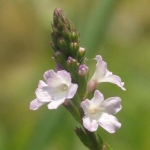| Common Name: |
Holy Herb |
| Other Names: |
European Vervain, Herb of the Cross, Pigeonweed, Traveler's Joy, Verbena, Vervain |
| Botanical Name: |
Verbena officinalis |
| Genus: |
Verbena |
| Family: |
Verbenaceae |
| Native Location: |
Europe, W Asia, N Africa |
| Cultivation: |
Well-drained, moist soil in sun. |
| Propagation: |
By seed sown in spring or autumn; by division in spring; by stem cuttings in late summer. Self-sows freely. |
| Harvest: |
Plants are cut as flowering begins, and dried for use in decoctions (Chinese medicine), infusions, liquid extracts, ointments, and tinctures. |
| Height: |
80cm (32in) |
| Width: |
60cm (24in) |
| Hardiness: |
Z4-8 |
| History: |
Here is another herb, whose origins lie in the tears of an ancient goddess. Early Egyptians believed vervain grew from the tears shed by Isis over her murdered husband Osiris. Ancient Roman soldiers wore wreaths of vervain to protect them from their enemies, and the early Christians believed vervain was the herb use to stop Christ's bleeding on the cross. The ancient Anglo-Saxon tribes of Britain regarded vervain as a sacred food and ceremonial herb essential for practicing magic. They collected the plant only under dark, moonless nights, and every plant they dug up was replaced with a honeycomb as an offering of atonement to the gods for robbing the earth of a holy herb. They also used vervain to ward off demons, a use the persisted into medieval times, where vervain was believed to protect one from witches' spells. Native Americans used the herb for bladder, kidney and stomach ailments, and a tonic made from the flowers was believed to cure baldness. |
| Parts Used: |
Whole plant (ma bian cao) |
| Properties: |
A bitter, aromatic, cooling herb that is diuretic, calms the nerves, improves digestion, increases perspiration and lactation, reduces inflammation, and relieves pain; it controls bleeding, improves liver and gall bladder function, and stimulates the uterus. Regarded as anti-malarial in Chinese medicine. |
| Medicinal Uses: |
Internally for nervous exhaustion, depression, convalescent debility, asthma, migraine, jaundice, gall bladder problems, and insufficient lactation. Externally for minor injuries, eczema, sores, neuralgia, and gum disease; also as a dentrifice. In Chinese medicine, for malaria, menstrual complaints, influenza, feverish illnesses, gum disease, abscesses, urinary disorders, and schistosomiasis. Combines well with Avena sativa (See, Oats), Cypripedium parviflorum var. pubescens (See, American Valerian) and Scuttelaria lateriflora (See, Virginia Skullcap) for depression.
Vervain has anti-inflammatory, astringent, calming, diuretic, pain-relieving, sedating, sweat-promoting, tonic, uterine-stimulating, and wound-healing properties. Vervain also regulates gallbladder, hormone, and liver functions; brings on delayed menstrual periods; and stimulates milk production in nursing mothers. In folk medicine, vervain is additionally used as an aphrodisiac. It is taken internally for anxiety, asthma, coughs, depression, fatigue, fevers, gallbladder, kidney, and liver ailments, headaches, inflammation, jaundice, menstrual irregularities, and pain. It is applied externally, in powder or tincture form, for eczema, gingivitis, and minor skin irritations. |
| Preparation: |
Vervain is available as dried herb and in capsules, teas, and tinctures. To make a tea, add 1 heaping teaspoon of dried herb to 1 cup of cold water and let stand for several hours. Strain, and drink up to 2 cups a day. |
| Culinary Uses: |
Flowers are used to flavor salt in Turkey, and may be added to salads or used as a garnish. Dried leaves are made into tea. |
| Economic Uses: |
Extract is used to flavor French liqueur Verveine du Velay |
| Warning: |
Excess causes nausea and vomiting.
Not recommended during pregnancy, but may facilitate contractions during labor. |
| Bibliography: |
Encyclopedia of Herbs by Deni Brown Copyright © 1995, 2001 Dorling Kindersley Limited. pp 401-402
The Modern Herbal Primer by Nancy Burke Copyright©2000 Yankee Publishing, Inc. pp. 101-102 |

